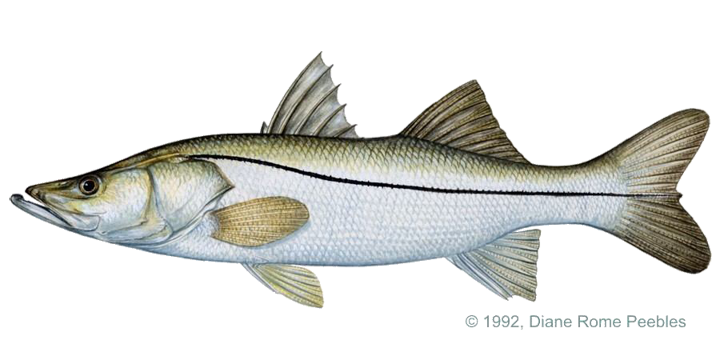Game Fish Identification Reference Guides
Snook (Atlantic)
(Centropomus spp.)
(Centropomus spp.)

CENTROPOMIDAE FAMILY also called robalo; (western Atlantic and Gulf of Mexico: C. parallelus Poey, 1860, fat; C. pectinatus Poey, 1860, tarpon; C. undecimalis (Bloch, 1792), common; C. mexicanus Bocourt, 1868, Constantino or Guianan ; C. ensiferus Poey, 1860, swordspine or swordfin; C. poeyi Chávez, 1961, Mexican and (eastern Pacific: C. nigrescens Günther, 1864, black snook; C. unionensis Bocourt, 1868, humpback or union; C. armatus Gill, 1863, longspine; C. viridis Lockington, 1877, white; C. medius Günther, 1864, blackfin; C. robalito Jordan & Gilbert, 1882, yellowfin)
The genus Centropomus is confined to the American tropics and subtropics. Six species occur in the Atlantic and six in the Pacific. None occur in both oceans. They inhabit shallow coastal waters, estuaries and brackish lagoons, often penetrating far inland in fresh water. Their movements between fresh and salt water are seasonal, but they stay close to shore and never stray far from estuaries.
They are very distinctive and it would be difficult to confuse them with any other fishes. The lower jaw protrudes and a highly prominent black lateral line runs from the top of the gill cover along the sides and all the way through the tail. The body is compressed and the snout depressed and pike like. Two dorsal fins are separated by a gap. The second anal spine is conspicuous, spurlike, much thicker than the first and third. The margin of the preopercle is serrate, with 1 5 enlarged denticles at angle.
One of the axioms relating to fish species is that the colors will likely be variable depending on season, habitat, and/or any number of other conditions. The snook is no exception. The back of the snook may be brown, brown gold, olive green, dark gray, greenish silver, or black, depending largely on the areas the fish inhabits. The flanks and belly are silvery.
Its diet consists mainly of fish and crustaceans. Fishing methods include trolling or casting artificial lures or still fishing with live baits like pinfish, mullet, shrimp, crabs, or other small fish. Best fishing is said to be on the changing tide, especially high falling tide around river mouths and coastal shores and night fishing from bridges and in ocean inlets. A flooding or rising tide is more productive at creek heads.
An excellent table fish with delicate, white, flaky meat, it is a member of the Centropomidae family, which also includes the 200 lb (90.72 kg) Nile perch (Lates niloticus) and the barramundi (Lates calcarifer). It usually matures by the third year and has a life span of at least seven years. It is very sensitive to temperature and may not survive at temperatures below about 60oF (15oC).
The genus Centropomus is confined to the American tropics and subtropics. Six species occur in the Atlantic and six in the Pacific. None occur in both oceans. They inhabit shallow coastal waters, estuaries and brackish lagoons, often penetrating far inland in fresh water. Their movements between fresh and salt water are seasonal, but they stay close to shore and never stray far from estuaries.
They are very distinctive and it would be difficult to confuse them with any other fishes. The lower jaw protrudes and a highly prominent black lateral line runs from the top of the gill cover along the sides and all the way through the tail. The body is compressed and the snout depressed and pike like. Two dorsal fins are separated by a gap. The second anal spine is conspicuous, spurlike, much thicker than the first and third. The margin of the preopercle is serrate, with 1 5 enlarged denticles at angle.
One of the axioms relating to fish species is that the colors will likely be variable depending on season, habitat, and/or any number of other conditions. The snook is no exception. The back of the snook may be brown, brown gold, olive green, dark gray, greenish silver, or black, depending largely on the areas the fish inhabits. The flanks and belly are silvery.
Its diet consists mainly of fish and crustaceans. Fishing methods include trolling or casting artificial lures or still fishing with live baits like pinfish, mullet, shrimp, crabs, or other small fish. Best fishing is said to be on the changing tide, especially high falling tide around river mouths and coastal shores and night fishing from bridges and in ocean inlets. A flooding or rising tide is more productive at creek heads.
An excellent table fish with delicate, white, flaky meat, it is a member of the Centropomidae family, which also includes the 200 lb (90.72 kg) Nile perch (Lates niloticus) and the barramundi (Lates calcarifer). It usually matures by the third year and has a life span of at least seven years. It is very sensitive to temperature and may not survive at temperatures below about 60oF (15oC).













